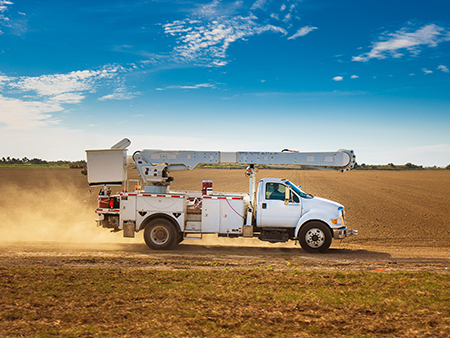Media contact: Yvonne Taunton
 National Science Foundation grant will reenvision manufacture and use of utility trucks. When disaster strikes, utility trucks are often among the first responders. Fleets of vehicles are deployed to restore order to the chaos of extreme climates or severe-weather situations, repairing the basic infrastructure that is needed to facilitate widespread relief and recovery efforts.
National Science Foundation grant will reenvision manufacture and use of utility trucks. When disaster strikes, utility trucks are often among the first responders. Fleets of vehicles are deployed to restore order to the chaos of extreme climates or severe-weather situations, repairing the basic infrastructure that is needed to facilitate widespread relief and recovery efforts.
An interdisciplinary team of researchers at the University of Alabama at Birmingham working in conjunction with Georgia Tech and a local industry partner recently received a grant from the National Science Foundation of nearly $1 million in support of a project that aims to create an advanced scientific framework that could revolutionize the way utility trucks are manufactured and operated.
Specifically, the researchers are developing plans for a new type of “smart” vehicle — one that can modify itself in real time, adapting to changing environments so that it can provide safe and efficient transport in extreme environments.
Vladimir Vantsevich, Ph.D., a professor in the Department of Mechanical Engineering and director of the Vehicle and Robotics Engineering Lab, is principal investigator on the project, which will receive $1 million in NSF support over four years. He will oversee the collaboration between the two universities, working alongside mechanical engineering professor Roy Koomullil, Ph.D., and civil engineering professor Nassim Uddin, Ph.D.
|
In addition to making utility crews safer and more efficient, Vantsevich says this project could have an even wider impact on the future of transportation research by:
|
Altec Inc., a longtime supporter of Vantsevich’s VREL facility, will also participate as an industry collaborator. The company, which manufactures utility trucks and equipment, will provide a utility truck for the experimental part of the project and will advise on engineering design.
Utility trucks are routinely deployed across different regions of the country into high-risk environments, where they clear roadways and restore power, among other duties. Because of the highly unpredictable conditions in disaster sites, Vantsevich says new and emerging technologies create the potential for these utility vehicles to be responsive to changing conditions — thus making them more efficient and safer for disaster relief personnel.
“We believe it is critical to create an advanced and effective scientific framework for maintaining productivity and safety while simultaneously eliminating accidents,” Vantsevich said. “This project aims to establish a novel and integrated framework to monitor and predict weather conditions. That information will then be fed into reinforcement learning mechanisms that will enable us to autonomously shape the utility trucks and keep them safe in severe environmental conditions by controlling road dynamics and aerodynamics of the trucks.”
The project is called “Aerodynamic Intelligent Morphing System for Autonomous Smart Utility Truck Safety and Productivity in Severe Environments.” In a synopsis of the project, Vantsevich explains that, “unlike conventional approaches, the A-IMS will integrate model-free shape-morphing learning mechanisms with model-based interactive design to manage air-fluid flows, based on the road conditions, meteorology, speed limit, wind speed and direction.”
The team of the professors and Ph.D. students will study the aerodynamic flows, geometric surfaces of the truck and the tire-road forces to keep the truck within a safe perimeter under an action of severe crosswinds and strong rains. This will be done by the A-IMS, an AI-based system, which can manage the weather information and make decisions to morph appropriate spoilers and to control aero flows around the truck as well as the tire forces that influence the position of the truck on the road.
In addition to making utility crews safer and more efficient, Vantsevich says this project could have an even wider impact on the future of transportation research by:
- bringing new perspectives of learning to enhance “smartness” of natural engineering systems that leverage physical and information processes;
- establishing an integrated design framework for hazardous environments to achieve resilience, as well as productivity through integrated adaptation of morphological properties while also mitigating the effects of potentially adversarial learning agents that can exist in the cloud; and
- investigating the interactive physical components of the A-IMS, which will simultaneously operate in two different mediums of multi-phase fluids and solids (i.e., the air-fluid and the road).
In addition to the previously named UAB faculty members, the project also includes education and outreach components that will mean opportunities for college and high school students. Integrated research and education plans will lead to technology transfer and summer camps with a special focus on reaching out to underrepresented minorities and women.